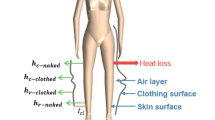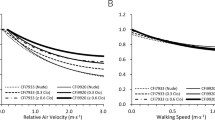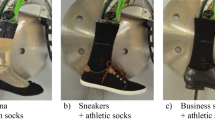Abstract
A limiting factor for clothing ensembles inherent during heat stress exposures is the evaporative resistance, which can be used to compare candidate ensembles and in rational models of heat exchange. In this study, the apparent total evaporative resistance of five clothing ensembles (cotton work clothes, cotton coveralls, and coveralls made of Tyvek® 1424 and 1427, NexGen® and Tychem QC®) was estimated empirically from wear trials using a progressive heat stress protocol and from clothing insulation adjustments based on ISO 9920 (2007) and wetness. The metabolic rate was moderate at 165 W m−2 and relative humidity was held at 50%. Twenty-nine heat-acclimated participants (20 men and 9 women) completed trials for all clothing ensembles. A general linear mixed effects model (ensemble and participants as a random effect) was used to analyze the data. Significant differences (p < 0.0001) among ensembles were observed for apparent total evaporative resistance. As expected, Tychem QC had the highest apparent total evaporative resistance at 0.033 kPa m2 W−1. NexGen was next at 0.017 kPa m2 W−1. These were followed by Tyvek 1424 at 0.015 kPa m2 W−1, and Tyvek 1427, Cotton Coveralls and Work Clothes all at 0.013 kPa m2 W−1. This wear test method improves on past methods using the progressive protocol to determine evaporative resistance by including the effects of movement, air motion and wetness on the estimate of clothing insulation. The pattern of evaporative resistance is the same as that for critical WBGTs and a linear relationship between apparent total evaporative resistance and WBGT clothing adjustment factor is suggested. With the large sample size, a good estimate of sample variance associated with progressive method can be made, where the standard error is 0.0044 kPa m2 W−1 with a 95% confidence interval of 0.0040–0.0050 kPa m2 W−1.


Similar content being viewed by others
References
Ashley CD, Luecke C, Schwartz S, Islam M, Bernard TE (2008) Heat strain at the critical WBGT and the roles of clothing, metabolic rate and gender. Int J Ind Ergon (in review with minor revisons)
ASTM (2002) Annual Book of ASTM standards––part 11.03. American Society for Testing and Materials, Conshohocken
Barker DW, Kini S, Bernard TE (1999) Thermal characteristics of clothing ensembles for use in heat stress analysis. Am Ind Hyg Assoc J 60:32–37
Belding HS, Kamon E (1973) Evaporative coefficients for the prediction of safe limits in prolonged exposures to work under hot conditions. Fed Proc 32:1598–1601
Bernard TE, Luecke CL, Schwartz SW, Kirkland KS, Ashley CD (2005) WBGT clothing adjustment factors for four clothing ensembles under three humidity levels. J Occup Environ Hyg 2:251–256
Bernard, TE, Caravello V, Schwartz SW, Ashley CD (2008) WBGT clothing adjustment factors for four clothing ensembles and the effects of metabolic demands. J Occup Environ Hyg 5:1–5
Brode P, Havenith G, Wang X, Candas V, den Hartog EA, Griefahn B, Holmer I, Meinander H, Nocker W, Richards M (2008) Non-evaporative effects of a wet mid layer on heat transfer through protective clothing. Eur J Appl Physiol (in press)
Goldman RF (1988) Standards for human exposure to heat. Environmental ergonomics: sustaining human performance in harsh environments. In: Mekjavic IB, Banister EB, Morrison JB (eds) Taylor and Francis, Philadelphia, pp 99–136
Havenith G (1999) Heat balance when wearing protective clothing. Ann Occup Hyg 43:289–296
Havenith G, Heus R, Lotens WA (1990) Clothing ventilation, vapour resistance and permeability index: changes due to posture, movement and wind. Ergonomics 33(8):989–1005
Havenith G, Holmer I, den Hartog EA, Parsons KC (1999) Clothing evaporative heat resistance––proposal for improved representation in standards and models. Ann Occup Hyg 43:339–346
Havenith G, Richards M, Wang X, Brode P, Candas V, den Hartog E, Holmer I, Kuklane K, Meinander H, Nocker W (2008) Apsparent latent heat of evaporation from clothing: attenuation and heat pipe effects. J Appl Physiol (in press)
Holmer I, Nilsson H (1995) Heated manikins as a tool for evaluating clothing. Ann Occup Hyg 39(6): 809–818
Holmer I, Nilsson H, Havenith G, Parsons K (1999) Clothing convective heat exchange––proposal for improved prediction in standards and models. Ann Occup Hyg 43:329–337
ISO/FDIS 9920 (2007) Ergonomics of the thermal environment: estimation of the thermal insulation and evaporative resistance of a clothing ensemble. International Standards Organization, Geneva
Kenney WL, Mikita DJ, Havenith G, Puhl SM, Crosby P (1993) Simultaneous derivation of clothing-specific heat exchange coefficients. Med Sci Sports Exerc 25(2):283–289
Lotens WA (1989) The actual insulation of multilayer clothing. Scand J Work Environ Health 15:66–75
O’Connor DJ, Bernard TE (1999) Continuing the search for WBGT clothing adjustment factors. Appl Occup Environ Hyg 14:119–125
Woodcock AH (1962) Moisture transfer in textile systems, Part I. Text Res J 32:628–633
Acknowledgments
We would like to thank all of the participants and study staff. This research was supported by a grant from the National Institute for Occupational Safety and Health (1R01 OH03983); and its contents are solely the responsibility of the authors and do not necessarily represent the official views of NIOSH, CDC, the United States Air Force or US Department of Defense. Clothing was provided by DuPont, Kappler and Red Kap Industries, and beverages were provided by Gatorade.
Author information
Authors and Affiliations
Corresponding author
Electronic supplementary material
Below is the link to the electronic supplementary material.
Rights and permissions
About this article
Cite this article
Caravello, V., McCullough, E.A., Ashley, C.D. et al. Apparent evaporative resistance at critical conditions for five clothing ensembles. Eur J Appl Physiol 104, 361–367 (2008). https://doi.org/10.1007/s00421-007-0655-9
Accepted:
Published:
Issue Date:
DOI: https://doi.org/10.1007/s00421-007-0655-9




